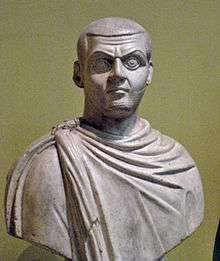313
Year 313 (CCCXIII) was a common year starting on Thursday (link will display the full calendar) of the Julian calendar. At the time, it was known as the Year of the Consulship of Constantinus and Licinianus (or, less frequently, year 1066 Ab urbe condita). The denomination 313 for this year has been used since the early medieval period, when the Anno Domini calendar era became the prevalent method in Europe for naming years. This year is notable for ending of the persecution of Christians in the Roman Empire.
| Millennium: | 1st millennium |
|---|---|
| Centuries: | |
| Decades: | |
| Years: |
|
| 313 by topic |
|---|
| Leaders |
| Categories |
|
| Gregorian calendar | 313 CCCXIII |
| Ab urbe condita | 1066 |
| Assyrian calendar | 5063 |
| Balinese saka calendar | 234–235 |
| Bengali calendar | −280 |
| Berber calendar | 1263 |
| Buddhist calendar | 857 |
| Burmese calendar | −325 |
| Byzantine calendar | 5821–5822 |
| Chinese calendar | 壬申年 (Water Monkey) 3009 or 2949 — to — 癸酉年 (Water Rooster) 3010 or 2950 |
| Coptic calendar | 29–30 |
| Discordian calendar | 1479 |
| Ethiopian calendar | 305–306 |
| Hebrew calendar | 4073–4074 |
| Hindu calendars | |
| - Vikram Samvat | 369–370 |
| - Shaka Samvat | 234–235 |
| - Kali Yuga | 3413–3414 |
| Holocene calendar | 10313 |
| Iranian calendar | 309 BP – 308 BP |
| Islamic calendar | 319 BH – 318 BH |
| Javanese calendar | 193–194 |
| Julian calendar | 313 CCCXIII |
| Korean calendar | 2646 |
| Minguo calendar | 1599 before ROC 民前1599年 |
| Nanakshahi calendar | −1155 |
| Seleucid era | 624/625 AG |
| Thai solar calendar | 855–856 |
| Tibetan calendar | 阳水猴年 (male Water-Monkey) 439 or 58 or −714 — to — 阴水鸡年 (female Water-Rooster) 440 or 59 or −713 |

Emperor Maximinus II
Events
By place
Roman Empire
- February 3 – Edict of Milan: Constantine the Great and co-emperor Licinius meet at a conference in Mediolanum (modern Milan). They proclaim a policy of religious freedom for all, ending the persecution of Christians in the Roman Empire and returning property confiscated from Christians.[1] The edict is posted in Nicomedia on June 13.
- Emperor Maximinus II crosses the Bosphorus with an army of 70,000 men and lays siege to Heraclea (Turkey). He captures the city after eight days.
- April 30 – Battle of Tzirallum: Licinius defeats his rival Maximinus II and becomes Emperor of the Eastern Roman Empire. Maximinus flees to Nicomedia and commits suicide.
Asia
- March 14 – Emperor Jin Huidi is executed by Liu Cong, ruler of the Xiongnu state (Han Zhao). At the imperial new year he and a number of former Jin officials are poisoned. Crown prince Jin Mindi, age 13, succeeds, in Chang'an, his uncle Jin Huidi and becomes the new emperor of the Jin dynasty.
- Nintoku, the fourth son of Ōjin, becomes the 16th emperor of Japan.
By topic
Art
- Basilica of Maxentius and Constantine (Basilica Nova), Rome, is finished.
Religion
- February 3 – Edict of Milan: Constantine the Great and co-emperor Licinius meet at a conference in Mediolanum (modern Milan). They proclaim a policy of religious freedom for all, ending the persecution of Christians in the Roman Empire and returning property confiscated from Christians. The edict is posted in Nicomedia on June 13.
- October 2 – Lateran Synod: Donatism is declared a heresy.
- Arius preaches of the human nature of Jesus.
Births
- Didymus the Blind, Alexandrian theologian (approximate date)
- Shi Hong, emperor of the Chinese Jie state (d. 334)
Deaths
- March 14 – Jin Huidi, Chinese emperor of the Jin dynasty (b. 284)
- June – Pope Achillas of Alexandria
- August – Maximinus II, Roman emperor (b. 270)
- Dowager Zhang, empress of the Xiongnu state (Han Zhao)
- Zhang Huiguang, empress of the Xiongnu state (Han Zhao)
gollark: I disagree, we should arbitrarily reinvent all our software repeatedly.
gollark: Our various webrings should use diverse platforms to prevent horrendous beeizing due to compromises/bugs in one of them.
gollark: You have many and the renewal cost must be nontrivial.
gollark: It would possibly be cool to have a GEORGE-community-adjacent URL shortener also.
gollark: Great, antimemetics are functioning.
References
- Frend, W. H. C. (1965). The Early Church. SPCK. p. 137.
This article is issued from Wikipedia. The text is licensed under Creative Commons - Attribution - Sharealike. Additional terms may apply for the media files.